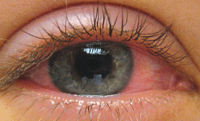 Which is better: the one-month or two-week replacement contact lens modality? The answer to that question is not as simple as it may seem.
Which is better: the one-month or two-week replacement contact lens modality? The answer to that question is not as simple as it may seem.
Logically, it would make sense that if a contact lens was replaced more frequently that it would be healthier for the eye, leading us to believe that the daily disposable option likely would be the best of all. And, perhaps that is true in a perfect world. But, reality must account for several other factors, including patient non-compliance in lenses, solutions, cases and follow-up exams.
In our own academic clinical practice, we instruct the students to ask two questions: how often does the patient replace his lenses and how old is the patient’s current pair. The students are amazed that, while the answer to the former may be two weeks, the answer to the latter is often anywhere from two weeks to six months––and, on occasion, even two years!
So, if we can agree that no patient or modality is perfect, and work under the premise that not everyone is able and/or willing to use a new lens each day, let’s examine some evidence to help us decide which is better…the one-month or the two-week.
The Argument for One-Month Lenses
Perhaps it is telling that the availability of a two-week disposable lens is waning, while the one-month lens market is expanding with the introduction of newer materials and increased availability in torics and multifocals. But, let’s look at the literature.
Kathy Dumbleton, O.D., M.S., and colleagues at the University of Waterloo surveyed more than 500 silicone hydrogel soft lens wearers from seven optometric practices.1 They found that 49% wore the two-week replacements and 51% wore the one-month alternative. Sixty-seven percent of all participants wore their lenses longer than the manufacturer’s recommendations; two-week wearers had a non-compliance rate of 82%, with a mean replacement frequency 2.6 times over the manufacturer’s recommended replacement frequency (MRRF), while the one-month wearers were at a 53% non-compliance rate, with a replacement frequency that was 1.5 times over the MRFF.1

Contact lens non-compliance can result in red eye.
Non-compliance was more significantly associated with self-reported contact lens-related problems, such as abrasions, conjunctivitis, discharge, discomfort, eyelid problems, infection or keratitis, photophobia, redness and sudden pain. However, there was no statistically significant difference between those in the compliant vs. non-compliant groups.1 This might help explain why patients continue in their bad habits despite our best efforts to educate them about the dangers.
Karen Yeung, O.D., and colleagues at UCLA found that non-compliance was highest in the two-week group, as well as in teenagers and patients fit in non-silicone hydrogel materials.2 Additionally, those who wore their lenses more than three times over the MRFF had a somewhat significantly higher number of complications.
Addressing Compliance
In an earlier study on compliance, Dr. Dumbleton found that the two most common reasons given by patients for overusing their lenses were forgetting the day (51%) and trying to save money (26%).3
To address the first concern, 53% of patients said that a reminder system would be useful; most selected an electronic reminder system. Fifty-two percent of compliant patients (compared to 28% of non-compliant patients) reported using a calendar or other system to help them remember when to change lenses. The study also reported that patients believed in the importance of having their doctor offer a detailed explanation of the replacement schedule; this finding was significantly higher in the compliant group.3 There are also a number of new, more hi-tech methods to remind patients to change their lenses at the appropriate time interval including downloadable apps, such as Lenstoss (Eyes) and Contact Lens Reminder (Ofijo), and free text- or email-based reminder services, such as Acuminder (Vistakon).
In terms of financial constraints, we certainly can be more cognizant of a patient’s situation prior to their fitting. There usually is some cost savings with lenses that have longer replacement intervals and, often times, there are manufacturer rebates available. Keep in mind that there are other factors at play, such as the patient’s attitude, face-to-face patient education and whether this is an initial fit or a subsequent follow-up exam.
As long as the two-week and one-month replacement options remain the most popular with our patients, we need to continue to review appropriate replacement intervals and potential ocular repercussions at each visit. Encourage your patients to be innovative, but consistent, in whatever method they use to stick to their schedule.
In the end, the literature suggests that compliance is better in the one-month replacement modality.1-3 While there does not appear to be a great disparity in reported contact lens-related complications due to non-compliance between the two groups, there may be more mild, and thus non-reported, problems that the patient self manages.
1. Dumbleton K, Woods C, Jones L, Fonn D. The relationship between compliance with lens replacement and contact lens-related problems in silicone hydrogel wearers. Cont Lens Anterior Eye. 2011 Oct;34(5):216-22.
2. Yeung KK, Forister JF, Forister EF, et al. Compliance with soft contact lens replacement schedules and associated contact lens-related ocular complications: the UCLA Contact Lens Study. Optometry. 2010 Nov;81(11):598-607.
3. Dumbleton K, Woods C, Jones L, et al. Patient and practitioner compliance with silicone hydrogel and daily disposable lens replacement in the United States. Eye Contact Lens. 2009 Jul;35(4):164-71.


